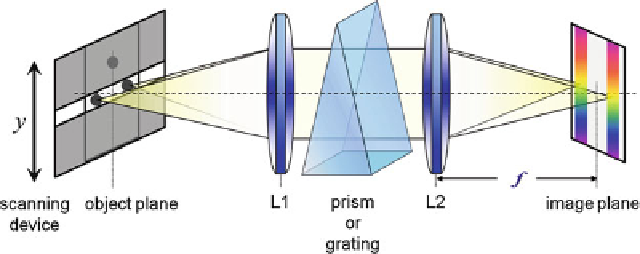Biomedical Engineering Reference
In-Depth Information
Fig. 4.12
Schematic description of a spectral imaging system with a grating or prism. One axis
of the array detector measures the dispersed spectrum for only a single line from the image, in
this case along x for a single point along y. Then, a scanning mechanism scans one line at a time
from the object. Note however that this is a simplistic description, while the actual optical setup is
different, see Fig.
4.13
The actual design of a spectral imaging system that is based on a grating or
a prism requires careful attention in order to correct different aberrations that
result from the nature of these elements. Two different names are used for the
systems that disperse the light.
Spectrometers
are the systems that isolate a single
wavelength from the whole spectrum and used either for isolated single wavelength
measurement or for measuring the spectrum by scanning one wavelength at a time.
A
spectrograph
on the other hand is used to disperse the whole spectrum along a
single axis. When a spectrograph is combined with an appropriate detector such
as a line of photomultipliers or array detectors, the full spectrum can be measured
simultaneously which is certainly an advantage.
Spectrometers and spectrographs have a different optical setup, and for spectral
imaging systems, it is certainly the spectrographs that should be used. Note,
however, that the terminology is somewhat ambiguous because every spectrograph
can be used also as a spectrometer by isolating a single wavelength from the whole
dispersed spectrum. Spectrographs suffer from intrinsic aberrations. The main ones
that must be corrected include field curvature, astigmatism, and anamorphism.
Field curvature causes the image of an object to be in focus on a curved surface
instead of a plane. Therefore, when the center of the image is in focus, the other
parts are blurred, and the further a point is away from the center, the more blurred
it is. Astigmatism is an aberration that causes a change between focal length for
vertical and for horizontal lines of the object. It therefore results in blurring of one
of the image's dimension or the spectrum and has to be corrected. Anamorphism is
another distortion that results in a nonuniform and variable size of each point that
should be in focus, and it depends on its position in the object plane so that the
object appears stretched in one dimension and thus must be corrected.
There are different optical designs that correct these aberrations to a satisfactory
level, and only the few most common settings will be described here. More
information can be found elsewhere [
29
,
30
]. The first system is based on the

Search WWH ::

Custom Search